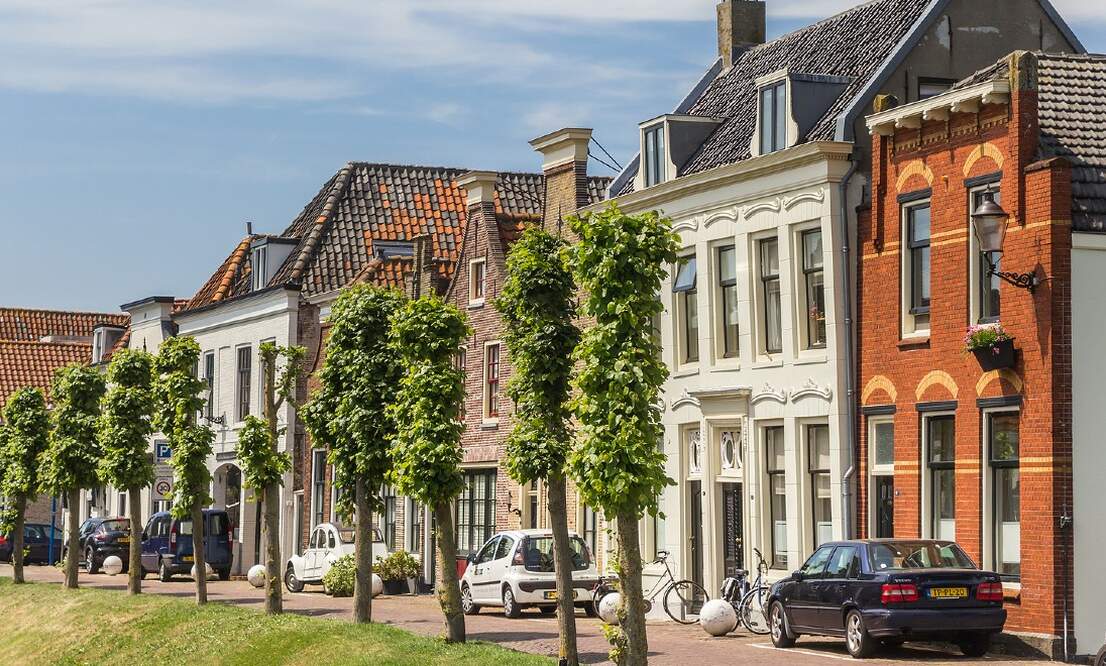The Bataviller are an ancient Germanic tribe that advanced along the Rhine and established a new settlement at the swamp mouth of the Amstel River where it meets the sea. The region fell into the hands of various Germanic tribes after the fall of the Roman Empire and during the dark ages of Europe. The people basically make a living by fishing.
Around 1200 BC, the first treehouses began to be built on artificial hills called “terp”. In what is now Dam Square, there is a dam built on the Amstel River. The dam not only controls the tides, but also gives direction to trade by preventing overseas ships from being loaded along the river. Goods to be transported need to be transferred to local boats for forwarding inland. Thus, the inhabitants of the region had an important source of income, and two important elements emerged in the history of the city: the strengthening of the trading class and the use of barges in trade with the hinterlands.
Dam Square – Dam Square:
Rokin Street, one of the tram routes leading to Dam Square, was a canal opening to this square, which used to be a port.
This canal from Muntplein was filled and turned into a street.
In 1275, the Dutch Count Floris granted permission to the inhabitants of the vicinity of the dam on the Amstel River to trade on the river without paying a toll, and granted a trade monopoly along the river. In 1323, this area becomes a duty-free port. At the end of the century, they began to export fish throughout Europe with high profitability, thanks to the method developed for the storage and drying of herring.
However, in 1345, an event of spiritual significance occurred in this town, a unique trading port. When a dying person is given communion bread (holy bread according to Christian tradition), he cannot swallow it. When the bread did not burn when thrown into the fire, this event was announced as a miracle, and within a few years Amstelredamme became a favorite pilgrimage site.
In 1419, Philippe of Burgundy unites the “low provinces” under one power.
After the great fires in 1421 and 1452, the use of wood in the construction of buildings in the city was prohibited and bricks were used instead.
Arrival of the Spaniards
After the marriages between European dynasties and developing family ties, Amsterdam was left alone for a short time during the Spanish rule.
In 1516, Charles V becomes sole ruler of the Spanish Empire and the Netherlands.
The fact that the city is an important trade port protects it from pressures encountered in other places, and even its population triples with immigration from other parts of the empire. Diamond cutting masters from Antwerp and Jews from Portugal add their own riches to the city.
Religious Strife
With the different groups that settled in the city, tolerance begins to develop. At the same time, Protestantism, the new Christian doctrine of Martin Luther, was spreading rapidly in Europe.
It was during this period that French Protestants (Huguenots) came to the city.
With the rapid spread of Protestantism in the city, Catholic Spain, which was on the opposite side, began to demonstrate its power with the inquisition courts. In 1535, anti-papal demonstrations took place in Dam Square. In 1550, the “Edict of Blood” was issued by the Spaniards. Accordingly, heretics will be caught and punished. After these events, 80 years of internal turmoil begins in Amsterdam and the Netherlands.
History of Amsterdam and the Netherlands
Noorder Kerk (North Church):
The building, which is a Protestant church, lost its treasures due to fires and looting during the Alteration (reform movements in the country). Today, it can be seen as an exhibition hall.
The Spanish King Charles V, originally from this region, sent the Duke of Alva to Amsterdam in 1567. Thus, the Spanish military administration, which took over the administration, imposes heavy taxes on the city.
Against this oppressive rule, the House of Orange, who came from a small town in France, claims the territory of the region and the dynasty member William the Silent starts an armed resistance against the Spanish rule.
In 1578, the people of Amsterdam revolt against the Papal forces and drive them out of the city (the Alteration period). The violence of the Inquisition against Protestants, this time against Catholics, and Catholic churches are looted.
In 1759, the seven states in the North Rhine broke the Spanish pressure and established the Union of Utrech. In 1648, with the Treaties of The Hague and Westfalen, the independent Dutch State, which is very close to its present borders, was established.
Development of trade
As Spanish influence wanes, the Dutch star becomes brighter and closeness is established with Portugal, which made trade deals with the East and was the sole source of new goods such as spices and silk. Amsterdam merchants make high profits by buying these goods and selling them in the Northern regions. The Netherlands lives its golden age between 1600-1700.
When the Spaniards captured Portugal in 1580, the merchants of Amsterdam embarked on this trade and in 1595 they sent their own fleets to India. The Dutch-East India Company, founded in 1602, monopolized trade on all routes east of the Cape of Good Hope. The Amsterdam-based company turns into a more powerful trading empire than many countries over time.
Financial structuring and subsequent banking practices that started in Italy in order to meet the rapidly developing commercial needs also developed in this period.
The welfare economy in the city also supports fine arts and scientific studies. Famous artists such as Rembrandt, Frans Hals, Vermeer and Paulus Potter lived in this period.
In the 16th century, public executions were held at The Waag building. The same building was used as a weighing house in the early 17th century, where the loads carried along the Gelderskade Canal were weighed.
It is known that in the upper floor rooms of the tower, the guilds came together and held meetings.
Founded in the city’s “Golden Age” period (1600-1700), the Surgeons’ Guild conducted research on cadavers and the structure of the human body in the meeting rooms in Waag, with the help of Antonie van Leeuwenhoek, who invented the microscope.
Two famous paintings of Rembrandt were commissioned by this guild and hung in this building when completed. “ Dr. Tulp’s Anatomy Lesson” brings the 17th century to our minds.
It was used for various purposes after the weighing house was closed at the beginning of the 19th century, it is still used as a restaurant.
The Waag:
Located in Nieuwmarkt Square, the “Waag” was opened in 1488 as a gate that marked the eastern border of the city, with new walls built after the great fire of 1452. It was located on the city walls at that time and was one of the entrance points of the city. The gothic building, which is shown as the oldest non-religious building in Amsterdam, is still used as a restaurant.

Decline and Decline
The greatest enemy of the Dutch on the high seas was the British. During the 17th and 18th centuries, there were major clashes between the two countries. Ultimately, England, which declared war in 1780, sank all the ships of the weakened Netherlands and did not allow it to regroup. Upon these developments, the Dutch-East India Company ended its commercial activities in 1791.
In the second half of the century, opponents of Orange, who wanted to form a government with French support, began to demonstrate and Napoleon Bonaparte captured the Netherlands in 1795. Thus comes the end of the Golden Age.
Napoleon’s brother Louis is proclaimed King of the Netherlands and settled in the Koninklijk Palace. Four years later, when he wanted to increase taxes, he had to leave the city due to the riots.
Upon Napoleon’s military failures, Williem van Orange returns from exile and proclaims himself king in 1813. Efforts begin to cope with the economic collapse.
The industrialization process changes the city drastically. With the opening of the Central Station in 1889, the overseas past was left behind.
Central Station:
It is built on three artificial islands supported by 8,687 tree stumps.
The station was built on the old port wall, and some old canals in the city center are filled to be opened for motor vehicles. Dam Square becomes landlocked for the first time in its history.
In the same period, together with all the ongoing industrialization movements, the benevolent dignitaries of the city, preserving the spirit of the Victorian era, pioneered the construction of major museums and parks.
History of Amsterdam and the Netherlands
20th century: World Wars
The Netherlands remained neutral in World War I. In the first half of the century, land acquisition works that would enlarge the settlements and agricultural areas were emphasized.
He chose to remain neutral in World War II, but upon the invasion of Germany in 1940, the royal family and members of parliament escaped and took refuge in London. Protesting the persecution of Jews, Dutch dockworkers protest the situation with a one-day strike, but almost all Jews are taken to concentration camps. During the winter of 1944-45, the Germans withdrew essential items such as food and fuel from the city, leaving the people to starve.
Modern State
As the country tries to recover after the war, Indonesia and other Dutch colonies gain their independence.
The power of the people manifests itself and in Amsterdam it is seen that progress does not mean getting rid of the past. When contractors want to demolish canal houses and empty buildings, Amsterdammers do not allow demolition, thinking that they have inherited these structures. Today, this historical building has been preserved and any renovation project will cause great controversy.
The Netherlands joined the European Union in 1957.
The Netherlands’ great strength in agricultural production and trade contributes to its success together, and the country also becomes an important center for international companies with commercial relations with Europe. During the 1990s, it played a leading role in the work carried out in the process of removing borders, increasing the freedom of movement of people and increasing their commercial relations within the framework of the EU, as well as the transition to the euro currency.




















































